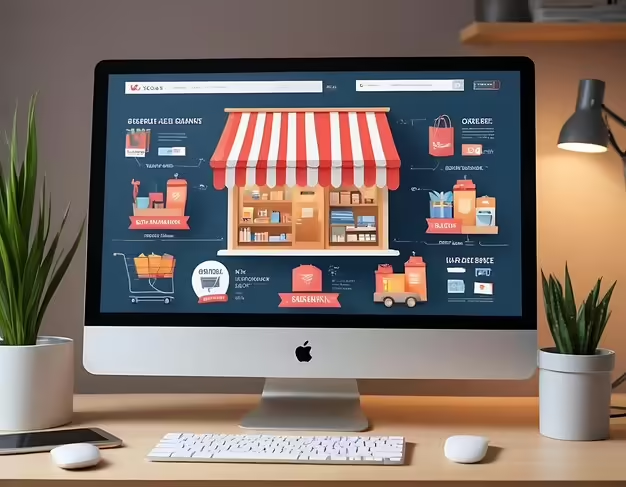With the digital marketplace booming, ensuring a strong online presence is crucial for small business success. In the same way that a physical store is layed out to attract people, advertise and sell them products, your e-commerce website will be your own virtual storefront which you have to design in order to help potential customers reach those goals.
It’s one thing to have a website, but that’s not the only thing you need. In an increasingly crowded digital world, your website had better be geared to turn visitors into paying customers. This is where e-commerce website design for small business enters the picture.
Not only from an aesthetic standpoint, but that needs to be consistent through for a better, calmer and overall more logical shopping experience for users that keep them coming back again.
The Importance of E-commerce Website Design for Your Small Business
Your website is like your digital handshake with the world around you. The other question this raises is what first impression does it give? Does it look welcoming, engaging and navigates easily? Or is it cumbersome, complicated and annoying?
Within a split second, visitors have an impression about your site. In today’s online world, an e-commerce site that looks good and gets the job done can mean the difference between someone adding items to their cart — or heading off to your competitor.
This is why it is essential to invest in e-commerce website design for small businesses.
· You only have a few seconds to make your first impression — Using visual and user-centric design gives you trustworthiness and credibility, enabling further exploration.
· A Bad User Experience: — If a customer finds it difficult to navigate through your website, you can guarantee they will leave. Clear navigation and product information — when visitors reach your site, they should quickly be able to find exactly what they want to buy (or click through
· Display Your Products. Having detailed product descriptions, product images and clients feedback is your most important factor in displaying your products to its maximum number of customers to get sales.
· Mobile Responsiveness: Since most online shopping is done through mobile devices, your e-commerce website needs to be responsive and work without hassle on smartphones and tablets.
· SEO Optimization: A well-optimized website ranks higher in search engine results, thus increasing the possibility that your customers will be able to find you online.
· Brand Building: With the use of your website, you can also create a strong brand and get that story rolling. A unified design, reflecting the personality and value of your brand, evokes loyalty and builds recognition.
High-Converting Small Business E-Commerce Website Design Key Components
The development of a high %-conversion e-commerce website takes the right mix of technical functionality alongside design aesthetics. There are three main components to think about:
2- Intuitive Navigation Your website should feature a simple and intuitive navigation process, where it is clear from landing on your home page, what the unique value proposition of your agency is. Use the menu structure you know is familiar, clear section divisions, and be sure to include a well-placed search bar they can use to quickly find whatever it is they are after.
Breadcrumbs: Use breadcrumbs to let users know their location in the website hierarchy and they can navigate back to the previous pages easily. ·
· Clear call-to-actions: Drive users to take specific actions like “Add To Cart” or “Checkout Now” with clean, simple, and visually appealing CTA [s]queues.
2. Effective Product Display
· High Quality Images: Include professional quality, high-resolution images of your products from different angles Adding zoom and providing 360-degree views will increase the immersive experience.
· Compelling Product Descriptions: Offer detailed product information like features, advantages, specifications and size charts. Keep it simple, use short and direct sentences and make sure you convey the main points of your dealnet offer.
· Customer Reviews and Ratings: Inspire customer reviews, showcase prominently on product pages Good reviews help to create trust and social proof, influencing the final decision of potential customers.
3. Streamlined Checkout Process
· Options for guest checkout to reduce friction and improve conversion rates.
· Diverse Payment Options – Integrate services like credit/debit cards, all common digital wallets and more alternative payment methods by comprehensive paid plugins.
· Secure Checkout: Have a secured website and display a trust badge to make customers feel more confident during the check-out stage.
4. Mobile-First Design
· Responsive Website: Your website should be able to adapt automatically on various screen resolutions i.e., Desktop, Laptop, Tablet and Mobile.
· Mobile-Friendly Navigation: Menus, buttons and other interactive elements must cater to touchscreen use.
· Fast Loading- Time: Mobile visitors hate waiting. Speed up page load times by optimizing images, reducing code bloat and selecting a dependable hosting provider.
5. Search Engine Optimization
· Research: Low down what your potential customers are using to search for products or services that you offer.
· On Page Optimization: Please optimize the individual page titles, meta description, image alt text etc… with relevant keywords to get indexed by search engines better.
· Content Marketing: Produce detailed, topic-specific content around your products or niche to get more organic audience and build expertise of your website
6. Security and Trust
· SSL Certificate: Embed an SSL certificate that will secure data travelling between your website and customer’s browser helping them to perform a secure transaction.
· Privacy Policy: Fully specify what data is collected on your website and how you comply with it, by assuring customers that their personal information will be used securely.
· Trust Badges: Show security/vendor organization trust badges increase in trust authorities.
7. Customer service & engagement
• Live Chat: Do live chat for extremely quick assistance to customers who need answers for their questions or require any help regarding the purchase.
Contact Information (phone number, email address, physical address if relevant).
· Connect Social Media: Use social media integration to make relationships with customers and send traffic on your online store.
Top E-commerce Website Design Best Practices for Small Business.
Now that we’ve covered the essentials, here are some basics for e-commerce site design to help push people through to conversion:
1. KISS (Keep it Simple and Sweet)
· Neat and Easy on the Eyes: Do not bombard your site visits with an inundation of information or visuals The way you present matters too and it should be clean, uncluttered. Use whitespaces efficiently.
· Clear Navigation: Facilitate for visitors in finding what they need with unambiguous and intuitive navigational menu.
· Easy Checkout: Always provide an uncomplicated checkout process that inevitably helps in completing transactions quickly for customers.
2. Optimize for Mobile Devices
· Responsive Design: Make sure that your website is responsive and looks good on smaller devices.
· Mobile-Friendly Navigation: Make sure menus and buttons are optimized for touchscreens.
· Fast Speed downloading load images small code reduction to ensure rapid response by Mobile.
3. High-Resolution Image-and-Video Files get Response
· Professional Photography: Spend money on a professional product photographer who can capture your products in the most flattering way.
· Lifestyle Images: Use lifestyle images to show customers how your products will fit into their homes.
The “how” of your Email marketing mix: Product Videos: where possible, the use of relevant product videos to provide deeper/ more engaging information
4. Build Trust and Credibility
· Customer Testimonials: This involves putting up positive customer testimonials to encourage the belief that there is social proof and nurturing of Trust.
· Security Badges: Show badges from security providers to make your customers secure in the knowledge their data is safe.
· Get in touch: Provide accurate contact details to customers know you are real.
5. Promote Your Website
· Social Media Marketing: Advertise on social media networks where your target demographic live.
· Email Marketing: Capture email addresses from visitors and use this to keep in touch or promote new products within your store.
· Paid Advertising: Explore running paid ad campaigns through sites like Google AdWords, or across social media to help you attract concentrated leads back to your website.
Conclusion
And, in this age of e-commerce, a slickly designed website is not so much a luxury as it is a requirement for small businesses attempting to remain competitive. With the advice and best practices we covered in this article, you can build an online store that is not only appealing to visitors but also effectively converting them into dependable customers.
Always keep readjusting your e-commerce website Measure your websites progress all the time, get customer feedback and make changes to convert as much visitors into price shoppers and offer them a great online shopping experience.




